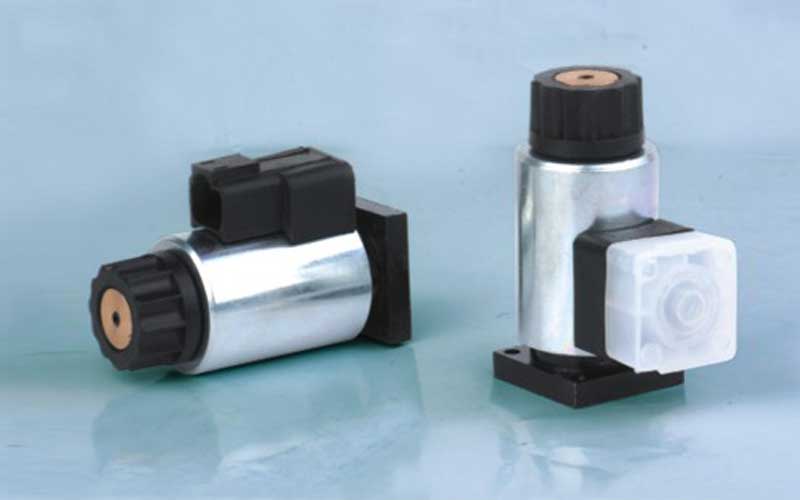The proportional solenoid is the most widely used electrical and mechanical conversion components that convert output signals into mechanical quantities. The proportional solenoid is mainly composed of an armature, a guide sleeve, a pole piece, a casing, a solenoid coil, a push rod and etc. The proportional solenoid is designed according to the Faraday electromagnetic induction principle, which can make the generated mechanical quantity proportional to the input electric signal, and continuously control the position of the hydraulic valve spool to continuously control the pressure, direction, and flow of the hydraulic system.
As the link between electronic technology and hydraulic technology, a proportional solenoid is a DC-stroke solenoid that produces an output, force and displacement proportional to the input. Its performance is very important for the characteristics of the proportional solenoid valve.
The necessary requirement for good proportional solenoid:
- It has horizontal suction, that is, the mechanical force of the output is proportional to the magnitude of the electrical signal, regardless of the displacement of the armature;
- With sufficient output force and stroke, compact structure, and small size;
- Good linearity, small dead zone, high sensitivity, and small hysteresis;
- Good dynamic performance and instant reaction;
- In the long-term work, the temperature rise will not be too large, and it will still work when the temperature rise is allowed;
- It can withstand high pressure in the hydraulic system and has good anti-interference.
The features of proportional solenoid
The attraction characteristic of proportional solenoid
A solenoid is an electric device that relies on the electromagnetic attraction generated by the electromagnetic system to make the armature work externally. The basic characteristic can be expressed as the relationship between the electromagnetic force Fm that the armature is subjected to during motion and its stroke X, that is, Fm=f(x). This relationship is called the suction characteristic.
In general, a proportional solenoid is required to have a horizontal suction characteristic. If the suction force of the solenoid is not horizontal, the spring curve and the electromagnetic force curve family have only a few intersection points, which mean that effective displacement control cannot be performed. In the working range, among the electromagnetic force curves that do not intersect the spring curve, if the corresponding current is below the spring curve, which will not cause the armature displacement; if the corresponding current is above the spring curve, output same current, the electromagnetic force will exceed the spring force, and pull the armature all the way to the limit position. Conversely, if the electromagnet has a horizontal characteristic, then under the same spring curve, there will be many intersections with the electromagnetic force curve family. At these intersections, the spring force is equal to the electromagnetic force, meaning that the armature can continuously stay at various positions as the input current is gradually increased.
The suction characteristic of the direct-acting proportional solenoid has the following characteristics: it has a basic horizontal displacement force characteristic within its working stroke range so that a certain control current corresponds to a certain output force, that is, the output force is proportional to the input current.
Load characteristic
During the movement of the solenoid, it is necessary to overcome the mechanical load and resistance to work. For ordinary solenoids, the electromagnetic suction force is generally required to be greater than load reaction force; for proportional solenoids, the armature is in equilibrium with electromagnetic suction force and load reaction force. Only in this way, the solenoid work normally. For keeping the reliable working of the solenoid, the suction characteristics and the load characteristics should be well matched.
In the working process, the electromagnetic force of the proportional solenoid is always balanced with the load force. There are many suction characteristic curve, and the load is mostly elastic load. The characteristic curve of the load spring intersects with multiple suction characteristic curves. Corresponding to different input currents, the curve of the electromagnetic force is shifted up and down, and the intersection point of the electromagnetic characteristic curve with the spring characteristic curve is the working point under the corresponding current.
The types and application of proportional solenoid
There are many types of the proportional solenoid, but the working principle is basically the same. They are all developed according to the control needs of the proportional valve.
According to the pressure level, it can be divided into proportional solenoids with high-pressure resistance and proportional solenoid without the characteristic of high-pressure resistance. The proportional solenoids that are not resistant to high pressure generally can only withstand the pressure of the return chamber of the relief valve, directional valve, etc. Due to the relatively simple structure, many electro-hydraulic proportional valves are still equipped with such kind of solenoids.
According to the output motion parameters, it can be divided into the linear type proportional solenoid and the rotary type proportional solenoid. Proportional solenoids with linear motion are the most widely used.
The proportional solenoids can be divided into force control type, stroke control type and position adjustment type according to the adjustment mode of the parameters and their connection method with the driven spool.
In addition, there are bidirectional polarization high-pressure proportional solenoids, proportional solenoid for cartridge valve, explosion-proof proportional solenoids, proportional solenoids with integrated proportional amplifiers, and so on. Some proportional solenoids are equipped with manual emergency devices at the end. When the control circuit fails and the proportional solenoid is de-energized, the proportional valve can be manually controlled.
